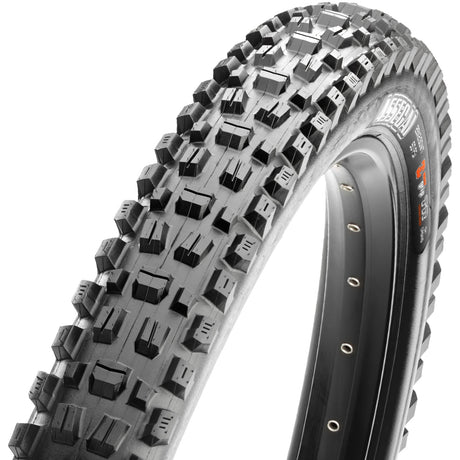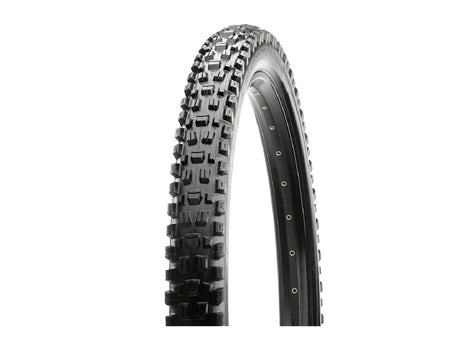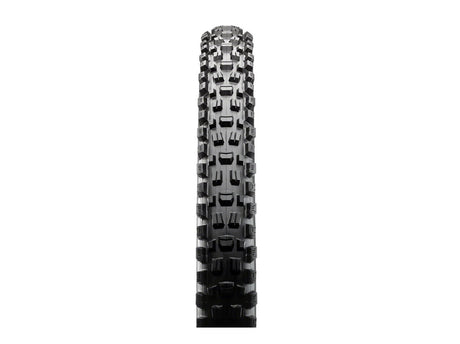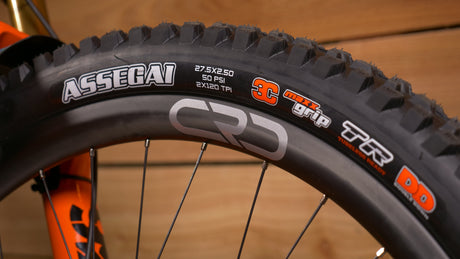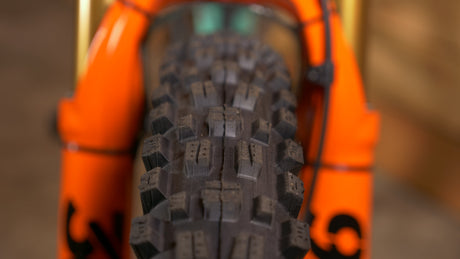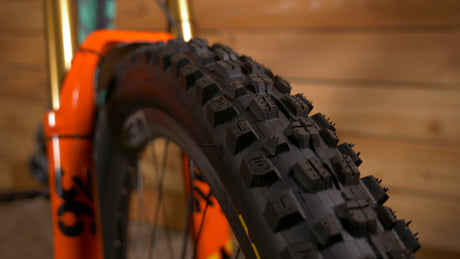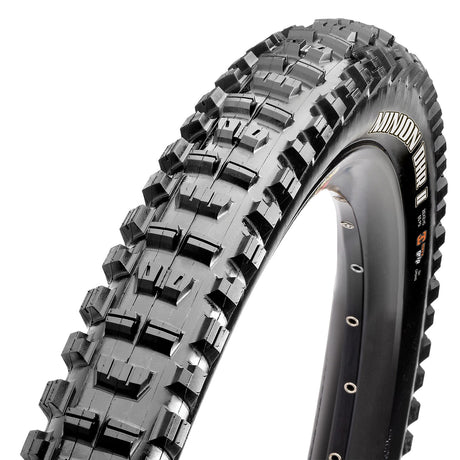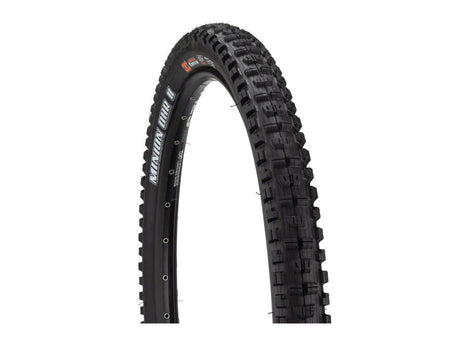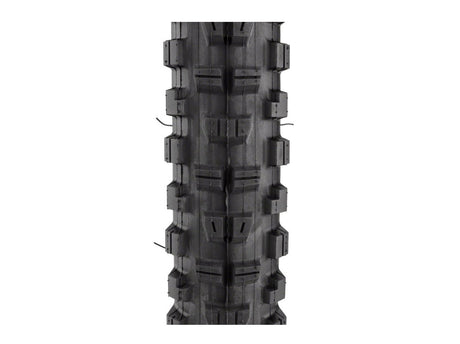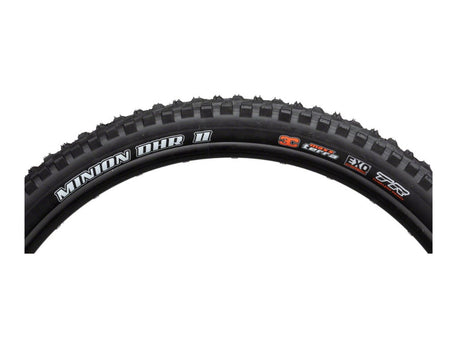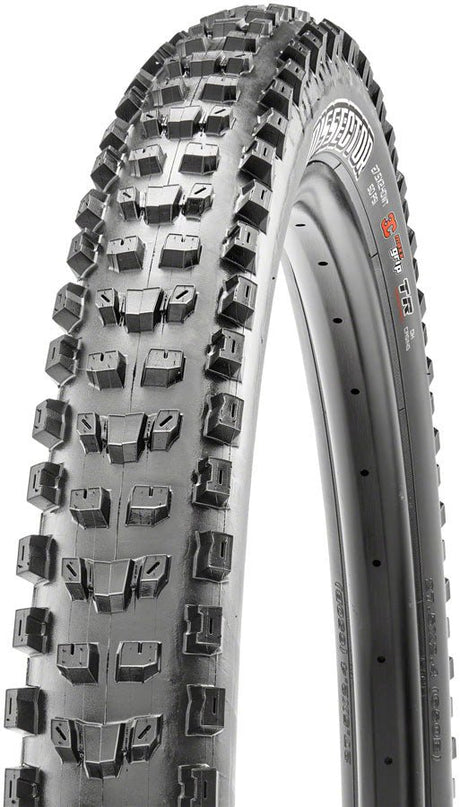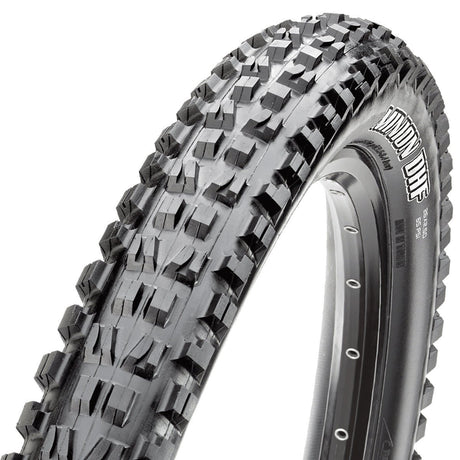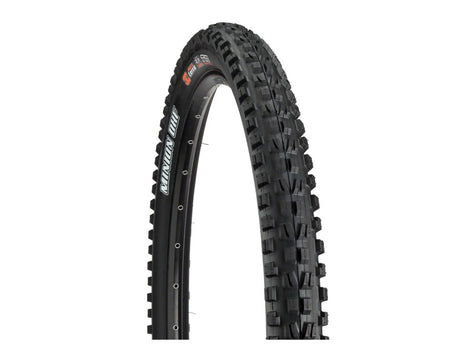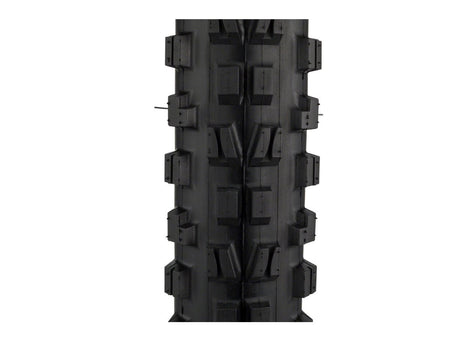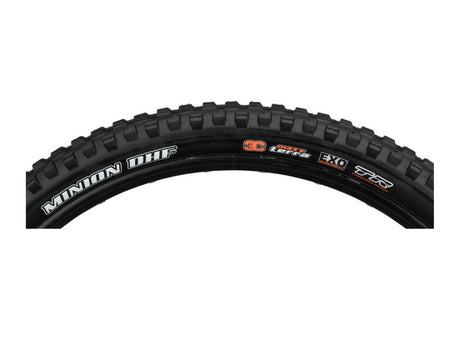Dual Compound vs MaxxTerra vs MaxxGrip
The rubber connected to your bike’s wheels is literally the only thing directly contacting the trail when you’re riding (except for the occasional pedal or maybe even a grip every now and then). In the last blog, we talked about Maxxis sidewalls, but in this one we’re going to talk about different compounds and help you decide which rubber is best for you and your riding.
When shopping for a new set of Maxxis mountain bike tires, you’ll see a whole bunch of acronyms and configurations. All of these options may seem pretty confusing at first. Don’t worry, when broken down, it's actually pretty simple.
One label stands for the model of sidewall (DD in the photo above). The other label represents the rubber compound (3C MaxxGrip in the photo above). When we say rubber compound, we’re basically just talking about the type of rubber used on the tire’s knobs.
The term “durometer” measures how firm or soft a tire’s rubber is. The lower the number, the softer and grippier the rubber. The higher the number, the harder and faster rolling a tire is. In this blog, we’re not going to get into durometers in order to make this explanation as simple as we can.
Overview of Maxxis MTB Tire Compounds
Maxxis makes three rubber compound options for their trail through downhill tire model range. Dual Compound is the most firm, MaxxTerra is a bit more soft, and MaxxGrip is the softest. Dual Compound is a very basic tire only using (you guessed it) two rubber compounds, while MaxxTerra and MaxxGrip use "3C Technology." 3C Technology utilizes three different types of rubber at various points on the tread to maximize various attributes such as grip and rolling speed.
Maxxis does make other compounds, such as MaxxSpeed, but that compound is commonly used on tires for Cross Country mountain bikes. In this particular blog, we are only focusing on compounds that are geared toward trail bikes through downhill bikes.
Ok, lets talk compounds!
Dual Compound uses a firm rubber at the base of the knobs, and a slightly softer rubber on the top of both the center and side knobs for a simple construction.
MaxxTerra uses a hard rubber at the base of the knobs, a medium rubber at the top of the center knobs for faster rolling speed, and a soft rubber at the top of the side knobs for increased grip while cornering.
MaxxGrip shares the same construction as MaxxTerra, but all of the rubbers used are softer and the soft rubber is used more for all out grip.
A Note On Maxxis Labels (Or Lack Thereof)
On some Maxxis tires, you will see there is no label indicating the compound. If you are purchasing the tire after market, then it is Dual Compound. If the Maxxis logo on the side of the tire is white, then that means it came stock on a complete bike. If there is no compound label on tires with the white logo, it is very likely a Dual Compound tire, but there is a slight chance it is a single compound tire.
How Each Compound Rides
Simply put, all three of these rubber compounds not only ride differently on the trail, but they also wear down at different rates and behave differently in each season. In order to best explain how they ride we will be talking about grip, rolling speed, how fast they wear out, and what compound is appropriate for what season. So let’s dig into the nitty gritty.
Grip Comparison of Each Compound
The main reason you would be changing rubber compounds is for grip.
Like we said before, the softer and stickier the rubber, the more all-out grip - Dual Compound offers the least amount of grip, MaxxTerra offers more grip, and MaxxGrip offers the most grip. Since most of your braking traction comes from the front tire, the changes in how much grip you achieve when switching out these rubber compounds are more noticeable on the front wheel.
For example, let’s say you go out on a 70 degree day where it’s dry, but not dusty, and you wanted to ride all three compounds to compare their grip...
You start with Dual Compound, and you ride totally fine. While your front tire does seem to lock up easily under heavy braking, chances are you’d successfully make it down the hill.
Next, you move on to MaxxTerra. You immediately notice how you can brake harder since the front wheel won't be sliding or locking up nearly as much. This is because MaxxTerra uses softer rubber, which grabs onto the ground easier and slows you down in a much more controlled manner. At the bottom of the trail, you probably say something along the lines of: “Holy crap I will never again run a Dual Compound tire up front!” The confidence you gain from a softer rubber compound up front was very apparent, and you’re stoked at how much harder the bike dug in while cornering and braking.
Then, you move onto MaxxGrip. You drop in, and the feelings that you encounter going from Dual Compound to MaxxTerra are amplified even more. You didn’t think it could get any better than that, but it did. You can brake harder and later, and redirect your bike with pinpoint precision. This is because the MaxxGrip rubber compound is super soft and sticky. When you stop to take a pee break halfway through the trail, you’ll notice the tire has more dirt stuck to it than a MaxxTerra would. Yep, it’s sticky enough to call it trail velcro. You get to the bottom, and you are freaking impressed with how much grip you got. You start wondering just how hard you can push your riding with such high amounts of grip.
All this front tire talk get’s you thinking: "What about the rear tire?"
So you do the whole experiment over again, but this time you realize how this actually changes your riding style. Dual Compound rubber is pretty firm, so it’s really easy to lock up the rear tire and slide around. Moving up to MaxxTerra is when you notice you can hook up even better in corners. This may lead to more confidence. You might start pushing the rear wheel into corners harder than ever before, but you will get more bite and less slide. Last but not least, MaxxGrip does it’s thing and sticks extremely hard in every situation. You can stuff the bike into anything, at more aggressive angles, and you simply hook real hard. You notice, however, that each time you went to a grippier rubber, the rear end becomes harder and harder to lock up and slide around.
If you like being able to drift around, you might consider sacrificing maximum levels of grip and going back to Dual Compound in the rear. Or, if you like a bit more of a controlled slide, MaxxTerra might be right for you. But, if you just really love being able to stick to the ground with less sliding, then MaxxGrip may be the most attractive option moving forward.
You probably also noticed that each tire bounces, or rebounds, a bit differently.
The softer a rubber is, the longer it takes to rebound from fully compressed. It’s sort of like taking your fork’s rebound setting and turning it full slow, then halfway through the clicks to a medium rebound speed, and then full fast.
- Dual Compound, being the most firm, will rebound the fastest and makes for a bit more of a poppy or active riding characteristic.
- MaxxGrip, being super soft, will rebound slower, with less pop but more of a planted, stable and controlled feel.
- MaxxTerra is right in the middle on the softness scale, and right in the middle of rebound characteristics. This may take a bit more on-trail brain power to really feel, but it’s something you’ll definitely notice at least subconsciously.
While in the midst of your tire tests, you may have noticed another characteristic about how each rubber compound rides… and that’s rolling speed.
Rolling Speed Of Maxxis Compounds
While more grip seems like the main goal, you may have noticed that more grip equals slower rolling speed.
The harder the rubber, the faster it rolls. The softer the rubber, the slower it rolls.
You’ll notice that your trail test with Dual Compound tires front and rear rolled noticeably faster compared to when you had MaxxGrip on the front and rear of the bike. As you can guess, this is because two firm tires on the bike will naturally roll faster than two soft tires. The MaxxTerra front and rear setup had a rolling speed right in the middle.
You may also notice that the change in rolling speed wasn’t as noticeable when swapping front tires when compared to swapping rear tires. This is because most of your weight is over the rear tire when pedaling or cruising on the trail. In those particular situations, rolling speed is more apparent since you’re wanting to carry speed. In contrast, that’s why the difference in grip was much more noticeable on the front - your weight really only goes over the front end under heavy braking.
At this point, you might start doing some technical thinking in order to figure out which rubber compound works best for you and your riding style. One issue though... you have two tires.
Choosing The Best Combo Of Maxxis MTB Tires For You
Now that you know how each tire grips, rebounds and rolls, you can take those factors into consideration and pick out the perfect combo of rubber compounds for your front and rear wheels.
Personally, I often climb 2,000 feet which results in 2,000 feet of descending down gnarly trails consisting of steep, rocky, and rooty sections. Even though I’m spending more time pedaling than descending, I really enjoy the time going downhill, so most of my focus of performance is on the downs. What I like to do is run MaxxGrip up front, and MaxxTerra in the rear. With that setup, I’ll have tons of steering and braking grip for the rough downhill with MaxxGrip up front. The MaxxTerra in the rear has less all-out grip, but it still has plenty of grip for the rear tire (which only covers about 25% of braking traction, anyhow). Plus, the MaxxTerra is more firm and rolls faster than if I went with the sticky MaxxGrip in the rear - again, all personal preference.
This combo leads to a setup with tons of grip for steep downhill trails, but provides enough rolling speed to keep me satisfied on both the climb up and while carrying speed down the trail. This is just my personal preferred setup, so please don’t copy replicate my tire setup simply because that’s what I like. You may have a similar riding style on different terrain, or have a different riding style on similar terrain - whatever the case may be, you may prefer a different combination of compounds.
Other combos follow the same guidelines. Dual Compound front and rear would roll super fast, but the braking traction wouldn’t be very impressive. MaxxTerra front and Dual Compound rear will roll super fast, but will have a more impressive amount of braking traction, etcetera, etcetera.
Basically you just need to decide which combination of grip and rolling speed works best for you and how you like to ride, then choosing compounds is a fairly simple decision. At this point, you’ve chosen your compound combo, then 3 months down the line you begin to notice one last thing… How fast do these rubber compounds wear out?
How Fast Compounds Wear Out
Another nutshell statement incoming:
The firmer the rubber, the slower it wears out. The softer the rubber, the faster it wears out.
Think of it like a pencil top eraser. Those super firm erasers from middle school would barely erase your spelling error, but holy crap it would last all school year (if you didn’t lose it in your locker). Those super soft erasers, on the other hand, would erase an entire page of math mistakes in no time, but it was so soft that you would leave behind a trail of rubber on the paper and wear down the eraser rather quickly.
The same principle applies to tires (though, not as aggressive as erasers), so you will want to take this into account when choosing compounds. Depending on how often you ride, and where you ride, your tires will wear out at different rates. Also, tires on either end of the bike wear out at different rates since you have more weight on the rear tire and less weight on the front tire.
Let’s say you ride 3 times per week in the Pacific Northwest, with 6 months of soggy mud riding and 6 months of dry hard-pack. There’s no way to give anyone an exact timeline of how long their tires will last before they want to replace them, but if a Dual Compound front tire lasts you, say, 2 years, MaxxTerra might last 16 months, and MaxxGrip might last 10 months.
This is EXTREMELY generalized, but that is about how it works. Your rear tire will wear out much faster since more of your weight is planted over it, so reduce those front tire lifelines by about 50% for the rear. The majority of the wear will be from the summer months, since a muddy and soggy trail abuses your tires less than a blown-out hard-pack trail.
And this leads me to my last topic… seasonality!
Seasonality
When our PNW trails get wet, the riding instantly steps up to 11 on the rowdy scale since wet roots hate you and want to sling you off the trail.
The sticky MaxxGrip really helps in these situations - the softer, stickier rubber conforms around roots and rocks more to help you grab every bit of traction possible. When it’s really wet and I’m shuttling a lot, I consider using MaxxGrip front and rear to get every bit of traction possible. The ground is soggy, and you’re going to be rolling slower anyhow, so a firmer rubber compound honestly won’t help your rolling speed much.
When summer hits, the ground dries out and gets very firm, so rolling speed and grip changes. I won’t be working against wet roots now, and maximum traction is a little less important. When I’m frequenting Whistler bike park, it’s generally super dusty and blown-out, and the ground is as hard as concrete. My go-to bike park setup is MaxxGrip front and Dual Compound rear. This is because I’ll be riding very fast and want tons of braking traction, but also my rear tire may be carving through 400 berms a day. Bike parks will literally eat tires, so it’s also nice that the Dual Compound tires are the cheapest option. This makes it less of a hit on the ol’ bank account when I go through 5-7 tires per bike park season. Running a MaxxGrip tire in the rear at the bike park day after day will actually resemble my pencil eraser analogy from earlier. The soft rubber in the rear combined with 15,000 feet of dusty descending per day wears that tire out very quick.
We definitely recommend taking seasonality into consideration with your tire combo. If you love how grippy a tire is, but don’t love how long it lasts you, then you may have to save some pennies and run a more firm tire so your wallet doesn’t hate you.
Another tidbit worth mentioning is that I generally like to replace my tires in the winter, if need be. The winter conditions wear down your tires much less, but you want your tires to be as fresh as possible for the most controlled ride during mud season. After 5 months of winter riding on new tires, you’ll still have nearly brand new looking tire tread when entering the dry season. If you replace your tires in the summer, they’ll be super worn out for winter which will lead to less than ideal amounts of grip for the wet roots and mud. This is, however, assuming that you run the same tires front and rear for the entire year like many people do. If you have specific winter and specific summer tires that you swap out, ignore this tidbit.
Final Thoughts
So there you have it - that’s the rundown on how your Maxxis tire (or any tire company) rubber compounds change how you ride due to the way it grips in corners, grips in straightaways, rebounds, rolls, and wears out. This can be quite daunting, but it’s actually one of the most fun bike parts to experiment with. Try out a bunch of different combos, and you’ll quickly be able to write a blog post of your own on how these different rubbers ride on the trail.
Ride, experiment, have fun, and ask us any questions you have about tires or anything else!

